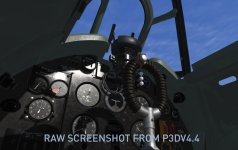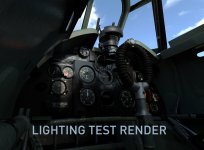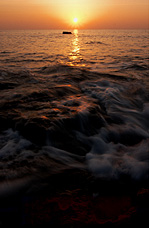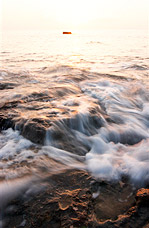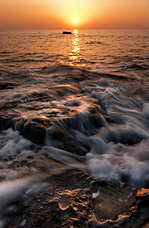Both images look fantastic. They easily could pass for real life photos. Although I'd doubt you ever see a Hurricane that pristine.
As far as "truth in advertising" I think a developer should use images in their advertising that approximate what a potential consumer will see on a mid-level system. When we did food commercials, we had to use the exact same product as the company provides to its consumers. That didn't mean we couldn't pick through 150 hamburger buns to find a photogenic one or hire a professional food stylist to cook and arrange the product.
The visible difference is what we film photogs called "latitude" or dynamic range. Wide latitude is the linear gradient display of detail in an image or filmstock. The render displays very wide latitude. The highlights blow out or "clip" in electronic terms in the P3D screenshot. modler has a valid point in that the human iris will contract or (stop down) in response to the brightest most prevalent source in its field of vision. I guess developers understand this when they design their wares.
Here's some pertinent info from the
www.cambridgeincolour.com if anyone is interested.
SENSITIVITY & DYNAMIC RANGE
Dynamic range* is one area where the eye is often seen as having a huge advantage. If we were to consider situations where our pupil opens and closes for different brightness regions, then yes, our eyes far surpass the capabilities of a single camera image (and can have a range exceeding 24 f-stops). However, in such situations our eye is dynamically adjusting like a video camera, so this arguably isn't a fair comparison.
| | |
| Eye Focuses on Background | Eye Focuses on Foreground | Our Mental Image |
If we were to instead consider our eye's instantaneous dynamic range (where our pupil opening is unchanged), then cameras fare much better. This would be similar to looking at one region within a scene, letting our eyes adjust, and not looking anywhere else. In that case, most estimate that our eyes can see anywhere from 10-14 f-stops of dynamic range, which definitely surpasses most compact cameras (5-7 stops), but is surprisingly similar to that of digital SLR cameras (8-11 stops).
On the other hand, our eye's dynamic range also depends on brightness and subject contrast, so the above only applies to typical daylight conditions. With low-light star viewing our eyes can approach an even higher instantaneous dynamic range, for example.
(*Quantifying Dynamic Range. The most commonly used unit for measuring dynamic range in photography is the f-stop, so we'll stick with that here. This describes the ratio between the lightest and darkest recordable regions of a scene, in powers of two. A scene with a dynamic range of 3 f-stops therefore has a white that is 8X as bright as its black (since 2[SUP]3[/SUP] = 2x2x2 = 8).)





